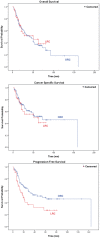Laparoscopic versus open radical cystectomy in 607 patients with bladder cancer: Comparative survival analysis
- PMID: 33714227
- PMCID: PMC9291606
- DOI: 10.1111/iju.14537
Laparoscopic versus open radical cystectomy in 607 patients with bladder cancer: Comparative survival analysis
Abstract
Objectives: To compare perioperative and oncologic survival outcomes between laparoscopic radical cystectomy and open radical cystectomy.
Methods: A total of 607 patients underwent open radical cystectomy (n = 412) or laparoscopic radical cystectomy (n = 195) at a single academic institution from January 2006 to April 2017. Their medical records were retrospectively analyzed. One-to-one propensity score matching was carried out to reduce selection bias. Estimated blood loss and complications were compared. Overall survival, cancer-specific survival and progression-free survival estimates for all patients and patients with locally advanced bladder cancer were analyzed using the Kaplan-Meier method.
Results: Either before or after matching, the laparoscopic radical cystectomy group had less estimated blood loss (P < 0.001 and P < 0.001) and fewer complications (P < 0.001 and P = 0.008). There was no difference in the overall survival (P = 0.216 and P = 0.961) and progression-free survival (P = 0.826 and P = 0.462) for all the patients having either laparoscopic radical cystectomy or open radical cystectomy. However, the 5-year progression-free survival of open radical cystectomy was higher than that of laparoscopic radical cystectomy (P = 0.019 and P = 0.021) for patients with locally advanced bladder cancer.
Conclusions: Laparoscopic radical cystectomy is superior to open radical cystectomy in terms of perioperative outcomes, and similar to open radical cystectomy in terms of oncologic outcomes for patients with early stage bladder cancer. However, for patients with locally advanced bladder cancer, laparoscopic radical cystectomy seems to be associated with shorter progression-free survival than open radical cystectomy.
Keywords: bladder cancer; laparoscopic radical cystectomy; open radical cystectomy; propensity score matching; survival outcomes.
© 2021 The Authors. International Journal of Urology published by John Wiley & Sons Australia, Ltd on behalf of the Japanese Urological Association.
Conflict of interest statement
None declared.
Figures





Comment in
-
Editorial Comment from Dr Kanno to Laparoscopic versus open radical cystectomy in 607 patients with bladder cancer: Comparative survival analysis.Int J Urol. 2021 Jun;28(6):680-681. doi: 10.1111/iju.14551. Epub 2021 Mar 13. Int J Urol. 2021. PMID: 33714225 No abstract available.
-
Editorial Comment from Dr Setoguchi and Dr Saito to Laparoscopic versus open radical cystectomy in 607 patients with bladder cancer: Comparative survival analysis.Int J Urol. 2021 Jun;28(6):681-682. doi: 10.1111/iju.14561. Epub 2021 Mar 27. Int J Urol. 2021. PMID: 33774869 No abstract available.
Similar articles
-
[Propensity-matched comparison of laparoscopic and open radical cystectomy for female patients with bladder cancer].Beijing Da Xue Xue Bao Yi Xue Ban. 2019 Aug 18;51(4):698-705. doi: 10.19723/j.issn.1671-167X.2019.04.018. Beijing Da Xue Xue Bao Yi Xue Ban. 2019. PMID: 31420625 Free PMC article. Chinese.
-
Can laparoscopic cystectomy become the method of choice in the treatment of invasive urothelial urinary bladder cancer?Adv Clin Exp Med. 2020 Mar;29(3):301-306. doi: 10.17219/acem/115084. Adv Clin Exp Med. 2020. PMID: 32207582
-
Perioperative and mid-term oncologic outcomes of robotic assisted radical cystectomy with totally intracorporeal neobladder: Results of a propensity score matched comparison with open cohort from a single-centre series.Eur J Surg Oncol. 2018 Sep;44(9):1432-1438. doi: 10.1016/j.ejso.2018.04.006. Epub 2018 Apr 17. Eur J Surg Oncol. 2018. PMID: 29699838 Clinical Trial.
-
[LAPAROSCOPIC AND OPEN RADICAL CYSTECTOMY FOR BLADDER CANCER].Vopr Onkol. 2015;61(3):352-61. Vopr Onkol. 2015. PMID: 26242145 Review. Russian.
-
The oncologic results of laparoscopic radical cystectomy are not (yet) equivalent to open cystectomy.Curr Opin Urol. 2009 Sep;19(5):522-6. doi: 10.1097/MOU.0b013e32832d9564. Curr Opin Urol. 2009. PMID: 19550335 Review.
Cited by
-
Robotic-assisted radical cystectomy with cutaneous ureterostomies: a contemporary multicenter analysis.World J Urol. 2024 Apr 23;42(1):251. doi: 10.1007/s00345-024-04942-1. World J Urol. 2024. PMID: 38652316
-
Impacts of enhanced recovery after surgery nursing interventions on wound infection and complications following bladder cancer surgery: A meta-analysis.Int Wound J. 2024 Apr;21(4):e14781. doi: 10.1111/iwj.14781. Int Wound J. 2024. Retraction in: Int Wound J. 2025 Apr;22(4):e70449. doi: 10.1111/iwj.70449. PMID: 38531376 Free PMC article. Retracted.
-
Extraperitoneal laparoscopic radical cystectomy with intracorporeal neobladder: a comparison with transperitoneal approach.World J Surg Oncol. 2022 Apr 23;20(1):130. doi: 10.1186/s12957-022-02587-1. World J Surg Oncol. 2022. PMID: 35459251 Free PMC article.
-
Systematic review and meta-analysis on laparoscopic cystectomy in bladder cancer.Transl Androl Urol. 2022 Jan;11(1):67-78. doi: 10.21037/tau-21-1076. Transl Androl Urol. 2022. PMID: 35242642 Free PMC article.
-
The clinical study of urinary flow parameters after drag-and-bond anastomosis for ileal orthotopic neobladder reconstruction.Int Urol Nephrol. 2024 Aug;56(8):2615-2621. doi: 10.1007/s11255-024-04015-7. Epub 2024 Mar 19. Int Urol Nephrol. 2024. PMID: 38502467
References
-
- Antoni S, Ferlay J, Soerjomataram I, Znaor A, Jemal A, Bray F. Bladder cancer incidence and mortality: a global overview and recent trends. Eur. Urol. 2017; 71: 96–108. - PubMed
-
- Miller KD, Nogueira L, Mariotto AB et al. Cancer treatment and survivorship statistics, 2019. CA Cancer J. Clin. 2019; 69 5: 363–85. - PubMed
-
- Witjes JA, Bruins HM, Cathomas R et al. EAU guideline on muscle‐invasive and metastatic bladder Cancer. 2019. [Cited 28 Feb 2021.] Available from URL: https://uroweb.org/guideline/bladder‐cancer‐muscle‐invasive‐and‐metastatic/
-
- Esquinas C, Alonso JM, Mateo E et al. Prospective study comparing laparoscopic and open radical cystectomy: surgical and oncological results. Actas Urol. Esp. 2018; 42: 94–102. - PubMed
Publication types
MeSH terms
Grants and funding
LinkOut - more resources
Full Text Sources
Other Literature Sources
Medical
Miscellaneous

